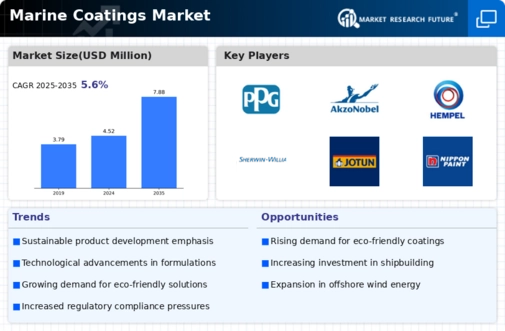Market Analysis
In-depth Analysis of Marine coatings Market Industry Landscape
The marine coatings market dynamics are influenced by several key factors that collectively shape its growth trajectory and trends. Here's a breakdown of these dynamics:
Demand from Shipbuilding and Maintenance: The primary driver of the marine coatings market is the demand from the shipbuilding and maintenance sectors. Marine coatings are essential for protecting ships and offshore structures from corrosion, fouling, and abrasion, prolonging their service life and reducing maintenance costs. As the global maritime industry continues to grow, the demand for marine coatings is expected to rise, influencing market dynamics positively.
Regulatory Compliance and Environmental Concerns: Compliance with environmental regulations, particularly regarding the use of antifouling coatings containing harmful biocides such as tributyltin (TBT) and copper, is a significant factor shaping market dynamics. Regulatory initiatives such as the International Maritime Organization's (IMO) International Convention on the Control of Harmful Anti-fouling Systems on Ships (AFS Convention) drive the demand for eco-friendly and low-toxicity coatings, influencing market dynamics towards sustainable solutions.
Technological Advancements in Coating Formulations: Ongoing research and development efforts have led to technological advancements in marine coating formulations, resulting in improvements in performance characteristics such as durability, adhesion, and resistance to fouling and corrosion. Innovations such as self-polishing copolymer (SPC) coatings, silicone-based foul-release coatings, and nanotechnology-enabled coatings influence market dynamics by expanding the range of available products and enhancing performance properties.
Growth of Offshore Energy Sector: The expansion of offshore oil and gas exploration and renewable energy projects drives the demand for marine coatings for offshore platforms, pipelines, and subsea equipment. With increasing investments in offshore energy infrastructure globally, the demand for corrosion-resistant and environmentally friendly coatings is expected to grow, influencing market dynamics positively.
Fluctuations in Raw Material Prices: The prices of raw materials used in marine coating formulations, such as resins, pigments, and additives, are subject to fluctuations due to factors like supply-demand dynamics and geopolitical tensions. Changes in raw material prices can impact production costs and influence market dynamics accordingly.
Competitive Landscape and Market Consolidation: The marine coatings market is characterized by intense competition among key players striving to gain market share through product differentiation, geographic expansion, and strategic alliances. Market consolidation through mergers, acquisitions, and partnerships also impacts market dynamics by reshaping the competitive landscape.
Demand for High-Performance Coatings: With increasing demand for high-performance coatings that offer long-term protection, durability, and reduced maintenance requirements, there is a growing preference for premium marine coatings. These coatings typically command higher prices and cater to specific requirements such as abrasion resistance, chemical resistance, and color stability, influencing market dynamics towards specialty coatings.
Impact of COVID-19 Pandemic: The COVID-19 pandemic has had mixed effects on the marine coatings market. While the initial disruption in global shipping and shipbuilding activities posed challenges, the increased focus on maritime trade and infrastructure investments for economic recovery has led to a rebound in demand for marine coatings, influencing market dynamics.
Market Penetration Challenges in Developing Regions: While developed regions such as North America and Europe dominate the marine coatings market, market penetration can be challenging in developing regions due to factors such as limited infrastructure, regulatory complexities, and preference for low-cost alternatives. Overcoming these challenges through education, market development initiatives, and strategic partnerships is crucial for driving market growth and influencing market dynamics in emerging economies.
Shift towards Digitalization and Industry 4.0: The adoption of digital technologies and Industry 4.0 principles in the maritime industry is driving innovation in marine coatings. Advanced coatings with features such as smart sensors, self-healing capabilities, and predictive maintenance functionalities are emerging, influencing market dynamics by enhancing performance and efficiency.












Leave a Comment